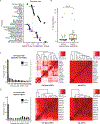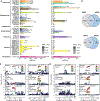Cell type-specific genetic regulation of gene expression across human tissues
- PMID: 32913075
- PMCID: PMC8051643
- DOI: 10.1126/science.aaz8528
Cell type-specific genetic regulation of gene expression across human tissues
Abstract
The Genotype-Tissue Expression (GTEx) project has identified expression and splicing quantitative trait loci in cis (QTLs) for the majority of genes across a wide range of human tissues. However, the functional characterization of these QTLs has been limited by the heterogeneous cellular composition of GTEx tissue samples. We mapped interactions between computational estimates of cell type abundance and genotype to identify cell type-interaction QTLs for seven cell types and show that cell type-interaction expression QTLs (eQTLs) provide finer resolution to tissue specificity than bulk tissue cis-eQTLs. Analyses of genetic associations with 87 complex traits show a contribution from cell type-interaction QTLs and enables the discovery of hundreds of previously unidentified colocalized loci that are masked in bulk tissue.
Copyright © 2020 The Authors, some rights reserved; exclusive licensee American Association for the Advancement of Science. No claim to original U.S. Government Works.
Figures





Comment in
-
Reaching completion for GTEx.Nat Rev Genet. 2020 Dec;21(12):717. doi: 10.1038/s41576-020-00296-7. Nat Rev Genet. 2020. PMID: 33060849 No abstract available.
Similar articles
-
The abundance of cis-acting loci leading to differential allele expression in F1 mice and their relationship to loci harboring genes affecting complex traits.BMC Genomics. 2016 Aug 11;17(1):620. doi: 10.1186/s12864-016-2922-9. BMC Genomics. 2016. PMID: 27515598 Free PMC article.
-
The impact of cell type and context-dependent regulatory variants on human immune traits.Genome Biol. 2021 Apr 29;22(1):122. doi: 10.1186/s13059-021-02334-x. Genome Biol. 2021. PMID: 33926512 Free PMC article.
-
Cellular deconvolution of GTEx tissues powers discovery of disease and cell-type associated regulatory variants.Nat Commun. 2020 Feb 19;11(1):955. doi: 10.1038/s41467-020-14561-0. Nat Commun. 2020. PMID: 32075962 Free PMC article.
-
Characterizing the Relation Between Expression QTLs and Complex Traits: Exploring the Role of Tissue Specificity.Behav Genet. 2018 Sep;48(5):374-385. doi: 10.1007/s10519-018-9914-2. Epub 2018 Jul 20. Behav Genet. 2018. PMID: 30030655 Free PMC article.
-
Cell-Type Heterogeneity in Adipose Tissue Is Associated with Complex Traits and Reveals Disease-Relevant Cell-Specific eQTLs.Am J Hum Genet. 2019 Jun 6;104(6):1013-1024. doi: 10.1016/j.ajhg.2019.03.025. Epub 2019 May 23. Am J Hum Genet. 2019. PMID: 31130283 Free PMC article.
Cited by
-
High-resolution genome topology of human retina uncovers super enhancer-promoter interactions at tissue-specific and multifactorial disease loci.Nat Commun. 2022 Oct 7;13(1):5827. doi: 10.1038/s41467-022-33427-1. Nat Commun. 2022. PMID: 36207300 Free PMC article.
-
The impact of sex on gene expression across human tissues.Science. 2020 Sep 11;369(6509):eaba3066. doi: 10.1126/science.aba3066. Science. 2020. PMID: 32913072 Free PMC article.
-
RET enhancer haplotype-dependent remodeling of the human fetal gut development program.PLoS Genet. 2023 Nov 10;19(11):e1011030. doi: 10.1371/journal.pgen.1011030. eCollection 2023 Nov. PLoS Genet. 2023. PMID: 37948459 Free PMC article.
-
Trans-eQTL hotspots shape complex traits by modulating cellular states.bioRxiv [Preprint]. 2024 Jul 8:2023.11.14.567054. doi: 10.1101/2023.11.14.567054. bioRxiv. 2024. PMID: 38014174 Free PMC article. Preprint.
-
Atherosclerosis: Recent developments.Cell. 2022 May 12;185(10):1630-1645. doi: 10.1016/j.cell.2022.04.004. Epub 2022 May 2. Cell. 2022. PMID: 35504280 Free PMC article. Review.
References
-
- Võsa U et al., Unraveling the polygenic architecture of complex traits using blood eQTL meta-analysis. bioRxiv, 1–57 (2018).
Publication types
MeSH terms
Substances
Grants and funding
- R01 CA229618/CA/NCI NIH HHS/United States
- U01 MH104393/MH/NIMH NIH HHS/United States
- R01 MH107666/MH/NIMH NIH HHS/United States
- R01 MH109905/MH/NIMH NIH HHS/United States
- R01 MH106842/MH/NIMH NIH HHS/United States
- MR/M004422/1/MRC_/Medical Research Council/United Kingdom
- U01 HG007598/HG/NHGRI NIH HHS/United States
- K99 HG009916/HG/NHGRI NIH HHS/United States
- R01 HL142028/HL/NHLBI NIH HHS/United States
- R01 HG006855/HG/NHGRI NIH HHS/United States
- R01 MH090951/MH/NIMH NIH HHS/United States
- T32 HG000044/HG/NHGRI NIH HHS/United States
- UL1 TR002550/TR/NCATS NIH HHS/United States
- WT_/Wellcome Trust/United Kingdom
- R01 HG010480/HG/NHGRI NIH HHS/United States
- R01 DA006227/DA/NIDA NIH HHS/United States
- U41 HG002371/HG/NHGRI NIH HHS/United States
- R01 HG008150/HG/NHGRI NIH HHS/United States
- UM1 HG008901/HG/NHGRI NIH HHS/United States
- U01 HG007593/HG/NHGRI NIH HHS/United States
- MR/R023131/1/MRC_/Medical Research Council/United Kingdom
- R01 GM124486/GM/NIGMS NIH HHS/United States
- R01 MH090936/MH/NIMH NIH HHS/United States
- HHSN261200800001C/CA/NCI NIH HHS/United States
- R01 HG002585/HG/NHGRI NIH HHS/United States
- F32 HG009987/HG/NHGRI NIH HHS/United States
- R01 HG010067/HG/NHGRI NIH HHS/United States
- R01 MH090941/MH/NIMH NIH HHS/United States
- R01 GM122924/GM/NIGMS NIH HHS/United States
- U41 HG009494/HG/NHGRI NIH HHS/United States
- R01 MH101822/MH/NIMH NIH HHS/United States
- R01 MH090937/MH/NIMH NIH HHS/United States
- T32 LM012424/LM/NLM NIH HHS/United States
- HHSN268201000029C/HL/NHLBI NIH HHS/United States
- HHSN261200800001E/CA/NCI NIH HHS/United States
- R01 MH101814/MH/NIMH NIH HHS/United States
- R35 HG010718/HG/NHGRI NIH HHS/United States
- P30 DK020595/DK/NIDDK NIH HHS/United States
LinkOut - more resources
Full Text Sources

